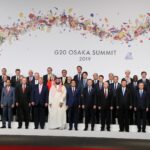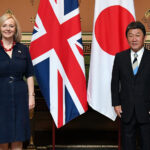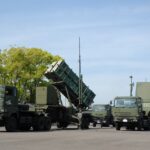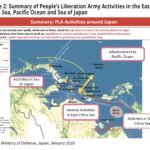Territorial disputes in the South China Sea continue to divide the international community and China. Koda Yoji, a former Japan Maritime Self-Defense Force Fleet Commander, shares his analysis of the state of affairs.

Map of Nations’ Claims in the South China Sea
VOICE OF AMERICA MAP, PUBLIC DOMAIN
On July 12, 2016, the Permanent Court of Arbitration (PCA) released its ruling on a claim brought by the Philippines against China on the South China Sea disputes between those two countries. The court rejected China’s claims on all thirteen issues taken up by the Philippines. But China refused to recognize the ruling, claiming “non-reception,” “non-participation,” “non-approval” and “non-execution” and maintains that position today, claiming that the ruling is not legally binding.
Over the last two years, the disputes between the international community, led by the United States, and China have remained largely unchanged, on the sidelines of the North Korea issue. In fact, China’s militarization of the artificial islands has seen tensions quietly rise, and the situation is getting worse.
The Essence of Maritime Issues Involving China
China has maritime issues with numerous countries in the South and East China Seas, but the essence of these issues can be roughly classified into the following three points.
(1) Conflicts on the dominions over maritime features
It is uncertain what country has the dominion over maritime features in the South China Sea with the exception of some maritime features because of their historical backgrounds. China has come in conflict with many coastal countries about the dominions over these maritime features. The basics of solving dominion issues are agreements between the related countries. Japan and the United States do not support a particular country and maintain a neutral stance, but if a particular country attempts to secure a dominion with military force, Japan and the United States will not remain neutral. In addition, China has claimed the areas surrounded by the “nine-dash line” as historic rights and indisputable sovereignty since before the Common Era, and the divide between China and the related countries is still deep.
The South China Sea Code of Conduct (COC), which reached a framework agreement in August 2017 to avoid unforeseen circumstances between China and the related countries, appears to involve basic conflicts regarding specific matters. The prospect of the COC as a sure-fire remedy for resolving the dispute between China and other countries, including the Philippines, is dubious.
(2) The construction of artificial islands and the non-militarization of the South China Sea
・The construction of artificial islands
Many maritime features are reclaimed in the South China Sea. Major examples of these are the Spratly Islands (Vietnam), Itu Aba Island (Taiwan) and Swallow Reef (Malaysia). These are expansions or reinforcements of existing large maritime features. China is also constructing artificial islands in several locations, including Weedy Island, the largest island in the Paracel Islands. China expelled the Vietnamese forces in the battle of the Spratly Islands in 1988 and established its effective control of small maritime features, including rocks, for the first time in its history. But China did not succeed in taking effective control of maritime features with sufficient areas for national activities. China, which needed a large base, subsequently embarked on the construction of artificial islands one by one in seven locations, including three large atolls on which it is possible to construct airports.
During this period of time, China did not fear the abovementioned conflict with the United States, continued with its construction work, completed all its construction projects this year and succeeded in establishing facts about its dominion over the artificial islands within its territory. At the same time, the PCA ruling totally rejected China’s construction of artificial islands. The conflict between the international community, including Japan and the United States, which support the ruling, and China is still intensifying.
・The non-militarization of the South China Sea
Chinese President Xi Jinping and US President Barack Obama reached an agreement on the non-militarization of the South China Sea in September 2015. The agreement was interpreted as meaning “China, which is forging ahead with the construction of artificial islands, will not militarize artificial islands (construct military installations and deploy military troops).” Regarding the interpretation of this agreement, China claimed, “The construction of any military installations and the deployment of military troops in our historic rights and indisputable sovereignty are a matter of state sovereignty and also just measures for defending ourselves as an independent state,” and completely undermined the agreement. Immediately after this, China reasoned that US military activities, including the presence of the US forces in the South China Sea, US joint military exercises with neighboring countries and US Freedom of Navigation Operations (FONOPS), are the militarization of the South China Sea. China strongly justified its construction of military installations on artificial islands and the deployment of Chinese troops.
According to the latest released information, China frequently deploys fighter aircraft on Woody Island, which is part of the Spratly Islands. In May this year, it was reported that the Chinese military’s large bomber H-6 had landed on the island for the first time. In addition, it has been confirmed that China constantly flies military transport planes over artificial islands and sends naval vessels to the islands. In addition to constructing radar facilities for early warning and surveillance as well as air control, and setting numerous information-collecting devices in place, China deploys anti-air and anti-ship missiles and electronic jamming devices. In this way, China is steadily militarizing the South China Sea, completely ignoring the agreement between the leaders of the United States and China.
(3) The open sea and internal waters
The most basic issue is the clarification of the control of the waters claimed by China, including the nine-dash line. Japan and the United States regard territorial waters as the open sea, where everyone is guaranteed free navigation, but China has a unique interpretation of the international standards on territorial waters which is completely different from that of Japan and the United States.
China’s claim is an attempt to bring the open seas of the South China Sea under the UNCLOS definition “internal waters,” giving it almost the same authority as territorial waters. The heart of the matter is that the open sea is waters to which UNCLOS and customary international law (international standards) are basically applied. Precisely because it is based on these two internationally common rules, even sailors in distant countries can navigate freely and safely in the waters with which they are unfamiliar, regardless of their geographical positions. These waters are the open sea. Conversely, because domestic laws, not international standards, are applied to internal waters under the sovereignty of a state just like territorial waters, if China’s claims are accepted, much of the South China Sea will become waters to which many Chinese domestic laws that sailors all over the world hardly know or do not need to know are applied. This means the destruction of the international maritime order that has been constructed by UNCLOS and customary international law, the fruits of wisdom for thousands of years since human beings advanced into the sea. The pillar of the dispute between China and the Philippines is that although the South China Sea is only part of the huge oceans all over the world, it must not be made into internal waters for China as an exception to the international maritime order.
If this is acknowledged, it will be possible to selectively force Chinese domestic laws on a particular country; if a conflict occurs between China and a particular country, China will be able to effectively disrupt that country’s maritime traffic in the South China Sea by applying an arbitrary domestic law. Such a serious situation, with the potential to destroy the international maritime order, cannot be overlooked.
Freedom of Navigation Operations (FONOPS)

Ships from the US Navy and Japan Maritime Self-Defense Force in the East China Sea following Keen Sword 2013. Keen Sword is a biannual exercise designed to increase combat readiness and interoperability of US forces and the JSDF within the framework of the US-Japan alliance.
US NAVY PHOTO, PUBLIC DOMAIN
The US military FONOPS is the diplomatic action of operating naval vessels as a means of showing US interpretation to a particular country if the United States and a particular country interpret the UNCLOS stipulations differently. FONOPS is not aimed solely at China, and there is a case in which FONOPS was also applied to Japan, a US ally.
US military FONOPS in the South China Sea can be divided into the following two cases: (1) Harmless navigation of military vessels according to the stipulations of UNCLOS in territorial waters whose sovereign state is undetermined with maritime features whose sovereign state has yet to be determined being the reference point; and (2) Free navigation according to China’s interpretation of UNCLOS, which is different from that of the United States, especially in the waters where China claims surrounding maritime features that cannot be the reference point of territorial waters; that is, the waters (the open sea) where there are no territorial waters stipulated by UNCLOS according to the US interpretation.
The harmless navigation of territorial waters defined by UNCLOS demonstrate warships’ rights. FONOPS are not designed to prevent a particular country from claiming a territorial issue or to call for the cessation of the construction of artificial islands.
After all, given the large gaps between the United States and China in their interpretations of UNCLOS and the current situation in which the gaps are unlikely to be closed rapidly, US FONOPS to China will continue to be conducted several times a year.
China Is Contained by Chains of Islands
China, which is determined to follow its national policy no matter what, and which has the capability to fulfill that policy given its economic and military power, has a huge impact on the stability of the region and acts as a challenger to the US-led world and the regional order. Surrounded on its southern and eastern sides by the South and East China Seas, which are semi-closed waters, China has the critical disadvantage of being contained geographically by neighboring countries. Chinese maritime and air forces must go through several choke points scattered around the islands and peninsulas in order to advance into open-sea operational waters and air spaces. In particular, there are just four channels that are more than 100 meters deep (two channels in each of the South and East China Seas) where submarines can navigate from the South China Sea to the open sea, submerged, where they could pose a serious threat to US forces. If these channels were blocked, it would be a critical blow to the Chinese maritime and air forces. The point is that although China can construct artificial islands self-righteously, ignoring UNCLOS, it cannot change the topography.
Japan and the United States can contain the advance of the Chinese maritime and air forces into the open sea and block the maritime traffic that is so essential for China’s survival by drawing up a strategy of controlling the aforementioned choke points in the island areas that surround China and building up defensive capabilities. This works as an effective deterrent to today’s China and also backs up diplomatic activities. Both Japan and the United States are expected to adjust their strategies from this perspective. For Japan, building up its defense capability with the same thing in mind is essential.
KODA Yoji is a former Fleet Commander of Japan’s Maritime Self-Defense Force.








